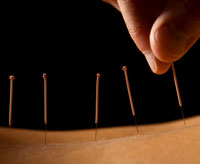A new study finds unique electrical phenomena through acupuncture meridians, channels. Researchers discovered that needling proximal acupuncture points causes significantly increased bioelectric amplitudes in distal acupuncture points along the same meridian. The same was not true of non-acupuncture points in similar regions of the body. The researchers note that the measurements indicate “electrophysiological uniqueness in the form of a greater bioelectric potential amplitude when a proximal acupoint is stimulated and the response is measured at a distal acupoint along the same meridian.”
 Acupuncture point P4 was stimulated with an acupuncture needle. The bioelectric potential was measured at acupuncture point P6 to determine if needling P4 elicited a change in the current. Non-acupuncture control points were also needled at nearby points on test subjects. The amplitude of induced signals at acupuncture point P6 showed significant increases on the test subjects whereas the non-acupuncture points did not have the same effects. The researchers measured that “a signal with statistically greater amplitude appeared only when a verum acupuncture point was stimulated and when the distal measurement was recorded on the acupuncture meridian.”
Acupuncture point P4 was stimulated with an acupuncture needle. The bioelectric potential was measured at acupuncture point P6 to determine if needling P4 elicited a change in the current. Non-acupuncture control points were also needled at nearby points on test subjects. The amplitude of induced signals at acupuncture point P6 showed significant increases on the test subjects whereas the non-acupuncture points did not have the same effects. The researchers measured that “a signal with statistically greater amplitude appeared only when a verum acupuncture point was stimulated and when the distal measurement was recorded on the acupuncture meridian.”
The researchers note that this type of bioelectric investigation is uncommon because most bioelectric investigations of acupuncture points and their meridians measure electrical impedances whereas this study measured endogenous bioelectric potentials. The electrical impedance studies involve the application of an externally generated electric current applied to an acupuncture point with subsequent measurements at other acupuncture points and regions of the body. This study, however, did not involve any externally generated currents. Rather, the current was naturally produced by the body as a result of manual acupuncture point needling. The “endogenous bioelectric potentials”, note the researchers, reflect changes in amplitudes without conflation with external currents. In this way, the researchers suggest that this new finding is more accurate. Another difficulty with prior bioelectric investigations was reading only high frequency currents. In this study, slower frequencies were also examined and the equipment was able to detect significant changes as a result of acupuncture point stimulation.
Reference:
Spaulding, Keith, Andrew Ahn, and Agatha P. Colbert. "Acupuncture Needle Stimulation Induces Changes in Bioelectric Potential." Medical Acupuncture (2013). New England School of Acupuncture, Newton, Massachusetts. Martinos Center for Biomedical Imaging, Charlestown, Massachusetts. Researcher, St. Augustine, Florida.

